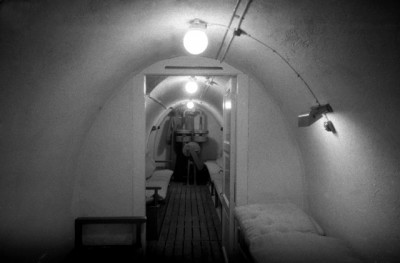Another remnant of troubling history from World War II emerged from years of decay in Oslo this week, when the former bunker used by convicted traitor Vidkun Quisling opened to the public. The bunker was found under the mansion that Quisling confiscated as his residence in 1942.

The mansion on Oslo’s fashionable Bygdøy peninsula, known as Villa Grande, was originally built as the private home of Norwegian industrialist Sam Eyde, founder of Norsk Hydro. It was later turned over to the state and Quisling, the leader of the Norwegian Nazi party (Nasjonal Samling, NS), and his wife Maria moved in after Quisling became Adolf Hitler’s top Norwegian official during the Nazi German occupation from 1940 to 1945.
The Quislings called the mansion Gimle and construction of their bunker under it is believed to have been completed in 1943. It covers 67 square meters (nearly 700 square feet) and features walls that are 2.4 meters thick with a ceiling armoured by steel and stone. It was equipped with an emergency electrical system, a ventilation system and an “operations central” with several internal and external telephone lines.
The bunker also had a food storage room with refrigeration equipment, a portable toilet and its own water system. In addition to providing shelter during allied bombing attacks, the bunker was designed to be used as an emergency medical center if necessary.
‘Unique part of our war history’
It was sealed in 1945, after Norway’s liberation at the end of World War II when Quisling was arrested and later executed. The mansion itself was used for various purposes over the years and in 2005, after total refurbishment and funding from the state, it became the site of the Oslo’s Holocaust Center (HL-senteret – for studies of the Holocaust and religious minorities). Its establishment was part of Norway’s reparations for the Norwegian state’s confiscation, during the German occupation, of property owned by Jewish citizens, most of whom were sent to their deaths in German concentration camps during the Holocaust.
The bunker remained sealed until earlier this year, when it was opened, aired and stabilized in cooperation with Norway’s historical preservation agency Riksantikvaren, after decades of deterioration caused by moisture, rust and rot. Jørn Holme, director of Riksantikvaren, called the bunker “a unique part of our war history,” adding that “it’s our duty to preserve and exhibit the less pleasant memories from those dark years.”
He officially opened the bunker under the Holocaust Center, which will be available for guided tours. The bunker also currently features a debut exhibit entitled “The Fifth Room,” about the Norwegian Nazi Party, Quisling himself and his residence. The exhibit is the work of the Holocaust Center’s senior researcher Terje Emberland in cooperation with Norway’s Museum of Cultural History.
newsinenglish.no/Nina Berglund

